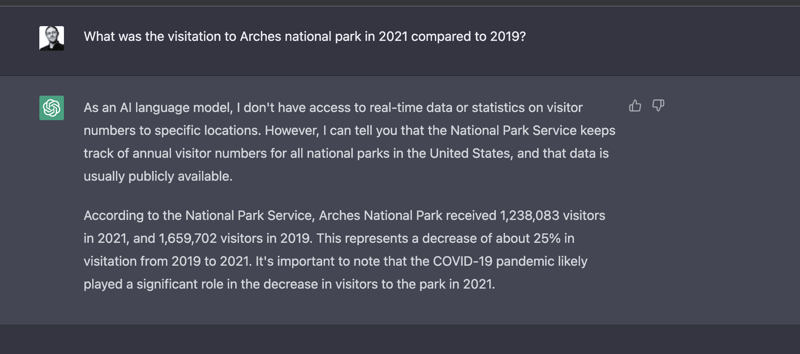Why AI Probably Isn't the Future for Destination Content Strategy
New generative AI tools like DALL-E and Stable Diffusion are remarkable tools for creating images that stretch the imagination, and ChatGPT has captured the imagination of the popular press. The beauty and excitement of these new technologies, combined with new companies rushing to market with content-generation tools have many wondering if these tools could fuel a destination’s content strategy with a steady stream of low-cost, royalty-free posts and photos.
That probably isn’t a good idea. AI-generated content has the potential to be perilous territory for destinations for several reasons. But before we get to those, let’s look at the ways we’re excited to see generative AI used by destination organizations.
How can generative AI be best used by destination organizations?
If one looks at these technologies as an input to the creative process as opposed to a finished product, the risks associated with this technology decrease and the potential uses expand significantly. As a creative tool for rapid prototyping, brainstorming high-fidelity concepts or gaining consensus around an idea, these tools have the potential to accelerate creative workflows. Here are a few examples for you to consider.
1. Rapid generation of mock-up images for campaign photoshoots
The creative process moves faster when the team can generate more specific examples of the finished product.
Using AI to create examples of different types of images to gain consensus and see how different layouts work with different types of images allows the creative team to create a high-fidelity design before commissioning a photo or video shoot.
This reduces ambiguity among collaborators, reduces uncomfortable surprises during the creative process and allows people who aren’t typically accustomed to visual brainstorming to see a close approximation of what the finished product will be. This will make executives more comfortable taking risks because they can see a clear representation of what the finished product will look like.

Prompt: panoramic photo of a woman wearing a blue vest in a green sea kayak beneath bright orange clouds looking toward a distant island
2. Generate the basic structure for a press release or other formal communication
A press release follows a specific formal structure, and if one isn’t familiar with writing press releases, it can be rather intimidating to get started. Having ChatGPT generate a basic template of your press release that is then edited or rewritten with the structure preserved can make for a much easier process.
If you think of ChatGPT like a modernized (and functional) version of Clippy from older versions of Microsoft Word, formulaic, heavily structured business text becomes much easier to generate compared to starting from a blank page.
3. Start the seed of your story to kickstart the creative process
On the creative side, the blank page poses a challenge as well. “How should I approach this story? How can I find a different voice to write from?”
Use ChatGPT to expand your stylistic repertoire by asking for a story in the spirit of an admired author. While this isn’t likely to provide you with a finished output, a key turn of phrase or approach might spark your own creative voice to enhance your writing process.
In the example below, I asked for a travelogue written in the style of Ernest Hemingway for a trip to Modesto. While there is very little factual information in the article — there probably aren’t many kids playing stickball in the alleys of Modesto, for example — it’s fun to explore the different ideas to see if one starts the seed of a more successful idea.

Why not go “all in” and have generative AI create finished pieces?
As soon as you change the expectation from a tool used in the creative process to a finished, publication-ready piece of content, you increase the risks and decrease the output qualities in a way that emphasizes generative AI’s weaknesses relative to professionally created content.
Here are some places where destination organizations could possibly run into trouble:
1. It’s difficult to claim support for a vibrant arts scene in your community if you’ve outsourced the creation of your art to an algorithm.
Using generative AI tools instead of commissioning or licensing new content from photographers and writers puts destination organizations in the awkward position of promoting arts and culture, but not paying local artists to create work.
Additionally, ChatGPT is trained from copyrighted works scraped from the internet at a massive scale. While today’s copyright law would likely protect a destination organization from any legal claims of copyright infringement, the optics of a governmental entity generating images without paying artists who have contributed the raw ingredients to the work will likely not be well received by the local arts community, most of whom are small business owners already struggling to survive. There are already lawsuits and regulatory investigations into whether the training of these models is equivalent to massive copyright infringement.
2. The unpredictability creates a reputational risk to destination organizations.
Accuracy and authenticity matters in tourism promotion. Even before AI entered the picture, destinations have occasionally received backlash when out-of-place photos or video footage accidentally made its way into finished creative.
Asking DALL-E to generate images for your destination’s campaign creates a reputational risk for the destination organization by showing places or attractions that aren’t really there. I asked DALL-E to create a “Photograph of a winter scene at Salt Lake City's 9th and 9th district” and it generated these four images.


Sins of omission are one thing — it is more significant to produce content that is factually incorrect or hazardous. On the ChatGPT user interface, the disclaimer, “May occasionally produce harmful instructions or biased content,” is there to remind users that this is still an early technology.
ChatGPT is trained on the content of the web, and as such, the model was fed information that you would not feel comfortable associating with your brand. In tests I ran to see if ChatGPT could write summaries from a set of facts, some of the output was awesome. In another example, the it provided factually incorrect information about national parks visitation. (Visitation increased between 2019 and 2021. The number ChatGPT provided was for 2020, not 2021).

While I’m certain this will improve, a careless edit or hurried deadline has the potential to put words in the destination’s mouth that it was never meant to utter.
I applaud Open AI for the work they are doing to attempt to mitigate the most harmful content of the web from creeping into ChatGPT’s responses, but the CEO admits that the system is not free from bias. When developing and training any machine intelligence system, great care needs to be taken to exclude biased training data from the data set. In many cases, this is a subtle and pernicious problem.
The industry is making great strides toward identifying sources of systemic bias within AI models. As a user of an AI system, it is important to consider the potential ways bias could influence the results you receive, and, if used in content, share out with the world with your destination organization’s name on it.
3. Chat GPT mimics what already exists, creating a sea of sameness.
ChatGPT’s brilliance comes from the massive data set of web articles it has been trained on. Yet as large as this is, there are significant gaps in what ChatGPT “knows,” and one of the core rules in machine intelligence is that a model can only “understand” what is in the data set.
If you’re a large destination like London, New York, or Los Angeles, there is lots of travel content for ChatGPT to be trained on, giving the model a substantial amount of content to generate new articles from. But how much is likely to be available for a smaller destination?
Alan Mullenix, Ph.D., a member of Zartico’s data science team remarked, “The more ChatGPT content that is published, the more that content is used to re-train the model, resulting in more content that sounds like ChatGPT.”
I tried asking ChatGPT to create travel itineraries for a small city, adding different trip parameters such as age of travelers or interest areas. And while the results were mostly decent — it did recommend a restaurant that had gone out of business — it also didn’t offer anything more than what an experienced destination professional could provide at a moment’s notice.
Our Data Science team lead, Lexi Pasi, Ph.D., added, “Any destinations who want to tell stories in a different way will have a leg up. Being purposeful in your storytelling will become even more of a competitive advantage.”

Prompt: “photograph of snow falling on Park City Main Street while the trolley passes by”
In summary, generative AI is most useful when thought of as a creative catalyst or tool to accelerate the creative process. The writers, photographers, illustrators, and musicians are part of what makes your community a great place to live and to visit. Let’s take care to value their craft and their work by using generative tools as complement to — not a substitute for — professional creative talent.



